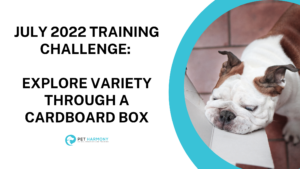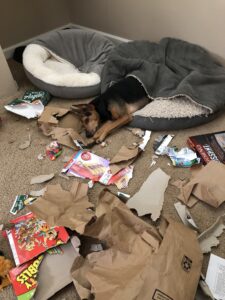
Happy July, y’all!
This month’s training challenge is inspired by one of our more frequently asked questions about enrichment.
What are some new enrichment things I can do for my pet?
We’ve all been there, right?
Scrolling through all the Instagram-worthy activities, looking at the plans professionals have developed for their own dogs and pets, thinking, “I really need to do more.”
Or watching your pet master your current offerings, so it feels like you need that next thing. Something that use to be exciting and fun has lost its spark (for you or your pet), so you’re looking for that excitement again.
And don’t get it twisted, I’m guilty of this as well! We have an obscene number of puzzle, foraging, and mental exercise toys for our dogs, but it’s a hobby for us, but not an expectation of an effective enrichment program. Because novelty isn’t always the answer.
Novelty isn’t a requirement. Is novelty a part of an effective enrichment plan? Sure. Maybe. For some creatures, but for all creatures? Definitely not.
And that leads me to this month’s training challenge:
Explore a variety of new ways to use a cardboard box (or you can broaden it to your recycling) in your enrichment plan.
I’ve worked with many species and cardboard boxes have been a staple in nearly all of their enrichment plans. They are versatile, regularly accessible, and downright effective. They are so useful that even Nathan Andrews talked about them in Episode 2 of Enrichment for the Real World!
You can use them as a foraging opportunity, to promote sniffing or shredding, to give the animal something to hide or rest in, to destroy, to obscure the environment, and more.
As you embark on this month’s challenge, here is some inspiration and food for thought:
- You can vary what is in the cardboard box, you can add your pet’s regular diet, treats, chews, frozen lickables, toys… the sky is the limit! Engagement with the box can lead to a variety of outcomes for your pet!
- You may need to start with something easy, like a few pieces of food in a shallow, open box. That’s okay! Meet your animal where they are!
- You can roll a box, put a box in a box, put things under a box, stuff the box with paper or leaves… get creative! If you’re looking for the next new thing to keep you entertained, flex those creativity muscles and see what you can come up with for yourself! Vary the way that you present the box.
- You can teach your pet to interact with the box, like with 101 Things to do With a Box, or use the box to teach a new trick.
In our household, we most often use boxes for “shreddables,” “destructables,” and foraging. When left to their own devices, complete and total destruction ranks high on preferred activities for our dogs. So, here are some examples of what that might look like to get you started!


Remember…
Enrichment is measured by its outcomes, not the activity. Let your pet’s behavior tell you what they need. It’s incredible what you can do with something as simple as a cardboard box (or recycling in general). If you find yourself looking for something novel, ask yourself, are you really looking for variety, increased difficulty, or complexity? You can achieve all of those things without needing something new, you just need to be a little creative!
Shreddables are nothing new to Griffey, and yet, it is still an incredibly effective activity for increased rest and relaxation throughout the day.

Now What?
- Observe your pet, and identify a behavior or two you’d like to approach with a cardboard box. Does your dog dig? Can you come up with a way to use a cardboard box or recycling to give them an appropriate way to dig? Does your pet destroy things? Maybe try some destructible to give them an appropriate way to destroy.
- Explore ways to add variety to your plan with a cardboard box, or other recycling!
- Follow us over on Instagram @petharmonytraining for more cardboard box and enrichment ideas!

